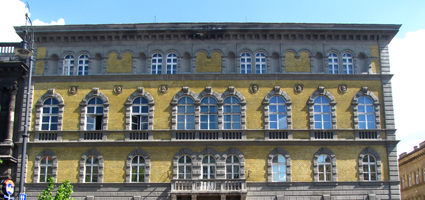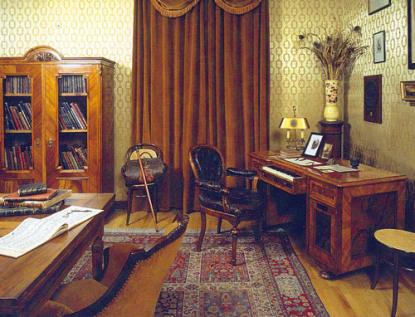2024. November 22. Friday
Liszt Ferenc Memorial Museum and Research Center - Budapest
 |
Address: 1064, Budapest Vörösmarty utca 35.
Phone number: (1) 342-7320, (1) 322-9804 /11611
E-mail: info@lisztmuseum.hu
Opening hours: Mon, Wed, Fri 10-18, Sat 9-17
|
Museum tickets, service costs:
|
Ticket for adults
|
2000 HUF
|
|
|
Ticket for students
|
1000 HUF
|
|
|
Ticket for pensioners
|
1000 HUF
|
|
|
Group guide
(max. 30 people)
|
12000 HUF
|
/ group
|
|
Audio guide
|
700 HUF
|
The Museum is a reconstruction of the apartment of the famous Hungarian composer and pianist. The building was built in 1879 to house the Hungarian Music Academy which had been established four years before due to the efforts of Liszt. He lived here in the last six years of his life being the president and professor of the Academy.

The dining-room serves as an exhibition-hall - the material of the temporary exhibits is changed every year. The Chickering-piano is a present from the factor. The instrument was rewarded with the golden medal at the 1867 world fair in Paris. Liszt used it in Szekszárd, in the house of his best Hungarian friend, baron Augusz.
To the right is the study-bedroom. In the corner there is a glass piano - it has glass slices instead of strings. Liszt's family is displayed above: the grandfather, the parents, the three children and his second life companion, the princess Carolyne Sayn-Wittgenstein. In the corner his prie-dieu can be found, with a rosary and a prayerbook which he received from the pope. On the wall religious reliquia and the certificate on his receiving of the four minor orders remind the religiousity of the artist. The bronze replica of Liszt's right hand was made by the sculptor Alajos Strobl in Budapest. The writing desk is a present from the piano-factor Bösendorfer. Its middle drawer hides a three-octave keyboard. On the desk Liszt's handwriting can be seen on a letter and a musical fragment. In the cabinet next to the door Liszt's personal belongings, such as cutlery, cigars, hair, walking stick and reliquia (hair locks) are exposed.
The drawing-room was the site of his piano-courses. A Chickering concert-piano (it stood once on the stage of the neighboring concert hall) stands at the window. On the silver music-stand donated by his friends from Budapest and Vienna, the portrait of Liszt and the busts of Beethoven, Schubert and Weber can be seen. Besides the beloved Bösendorfer piano a harmonium and a combined instrument, "piano-orgue" can be found. The large cabinet displays documents of his artistic career: concert programmes, conducting sticks, and travel effects: bag, lamp, and the mute piano he used on his concert tours. In the smaller cabinet the valuable presents (sword of honour, silver inkstand, gilt silver laurel wreath etc.) are stored. Above the cabinet the portraits of the princesses Maria-Valeria and Amalia adorn the wall. The Henri II style furniture was specially made for Liszt, the folkloric inspiration embroideries were made by elegant ladies in Budapest. At the door stands the piano which was specially made for Beethoven by Thomas Broadwood in London. After Beethoven's death the Viennese editor Spina bought it and presented it to Liszt, who took it to Hungary and leagued it to the Hungarian National Musem.

The dining-room serves as an exhibition-hall - the material of the temporary exhibits is changed every year. The Chickering-piano is a present from the factor. The instrument was rewarded with the golden medal at the 1867 world fair in Paris. Liszt used it in Szekszárd, in the house of his best Hungarian friend, baron Augusz.
To the right is the study-bedroom. In the corner there is a glass piano - it has glass slices instead of strings. Liszt's family is displayed above: the grandfather, the parents, the three children and his second life companion, the princess Carolyne Sayn-Wittgenstein. In the corner his prie-dieu can be found, with a rosary and a prayerbook which he received from the pope. On the wall religious reliquia and the certificate on his receiving of the four minor orders remind the religiousity of the artist. The bronze replica of Liszt's right hand was made by the sculptor Alajos Strobl in Budapest. The writing desk is a present from the piano-factor Bösendorfer. Its middle drawer hides a three-octave keyboard. On the desk Liszt's handwriting can be seen on a letter and a musical fragment. In the cabinet next to the door Liszt's personal belongings, such as cutlery, cigars, hair, walking stick and reliquia (hair locks) are exposed.
The drawing-room was the site of his piano-courses. A Chickering concert-piano (it stood once on the stage of the neighboring concert hall) stands at the window. On the silver music-stand donated by his friends from Budapest and Vienna, the portrait of Liszt and the busts of Beethoven, Schubert and Weber can be seen. Besides the beloved Bösendorfer piano a harmonium and a combined instrument, "piano-orgue" can be found. The large cabinet displays documents of his artistic career: concert programmes, conducting sticks, and travel effects: bag, lamp, and the mute piano he used on his concert tours. In the smaller cabinet the valuable presents (sword of honour, silver inkstand, gilt silver laurel wreath etc.) are stored. Above the cabinet the portraits of the princesses Maria-Valeria and Amalia adorn the wall. The Henri II style furniture was specially made for Liszt, the folkloric inspiration embroideries were made by elegant ladies in Budapest. At the door stands the piano which was specially made for Beethoven by Thomas Broadwood in London. After Beethoven's death the Viennese editor Spina bought it and presented it to Liszt, who took it to Hungary and leagued it to the Hungarian National Musem.
